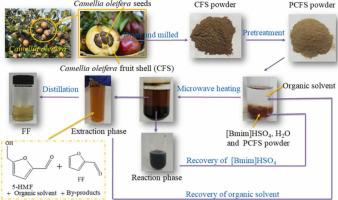Industrial Crops and Products ( IF 5.9 ) Pub Date : 2022-05-12 , DOI: 10.1016/j.indcrop.2022.115006 Lingling Huang , Hong Peng , Zhihong Xiao , Hong Wu , Guiming Fu , Yin Wan , Haoran Bi

|
The high-value utilization of Camellia oleifera fruit shell (CFS), which is an important waste in edible tea oil processing, is of great significance for the sustainable development of Camellia oleifera industry. In this study, the CFS after being simply pretreated (PCFS) to remove crude fat, pigment, et al., was used as material to produce furfural (FF) and 5-hydroxymethyl furfural (5-HMF) catalyzed by 1-butyl-3-methylimidazole hydrogen sulfate ([Bmim]HSO4). On the basis of comparing the superiority of microwave heating and traditional oil bath heating, on the basis of comparing the in-situ extraction of FF and HMF with four common solvents including 1,4-dioxane, methyl isobutyl ketone (MIBK), benzene, and cyclohexane, the [Bmim]HSO4/H2O/1,4-dioxane biphasic catalytic reaction system assisted by microwave irradiation was established. In this reaction system, FF was the chief product and 5-HMF was the chief by-product. The highest yields of FF and 5-HMF were 67.54 mol% and 20.97 mol%, respectively. The yield of FF was much higher than that of 5-HMF under the same reaction conditions. The kinetic analysis indicated that the hemicellulose hydrolysis to xylose catalyzed by [Bmim]HSO4 was the rate-limiting step in the production of FF. The cellulose hydrolysis to glucose and the subsequent isomerization of glucose to fructose were the rate-limiting steps in the production of 5-HMF. The rapid formation of other by-products was also one of the reasons for low yield of 5-HMF. [Bmim]HSO4 still performed excellent stability and catalytic activity after three times of cycles. FF with a purity of 95.26% could be obtained from the 1,4-dioxane phase under vacuum distillation. The relative contents of hemicellulose and cellulose and the crystallinity index of cellulose in PCFS residues decreased with the enhancement of reaction temperature and retention time. The biphasic medium used in this study was efficient for the production of FF from CFS.
中文翻译:

[Bmim]HSO4/H2O/1,4-二恶烷双相培养基中油茶果壳制备糠醛和5-羟甲基糠醛
油茶果壳(CFS)是食用茶油加工过程中的重要废弃物,其高价值利用对油茶产业的可持续发展具有重要意义。本研究以经过简单预处理(PCFS)去除粗脂肪、色素等的 CFS 为原料,以 1-丁基催化生产糠醛(FF)和 5-羟甲基糠醛(5-HMF)。 3-甲基咪唑硫酸氢盐([Bmim]HSO 4)。在比较微波加热和传统油浴加热的优越性的基础上,在比较 1,4-二恶烷、甲基异丁基酮 (MIBK)、苯、和环己烷,[Bmim]HSO建立了微波辐射辅助的4 /H 2 O / 1,4-二恶烷双相催化反应体系。在该反应体系中,FF 是主要产物,5-HMF 是主要副产物。FF 和 5-HMF 的最高产率分别为 67.54 mol% 和 20.97 mol%。在相同反应条件下,FF的收率远高于5-HMF。动力学分析表明[Bmim]HSO 4催化半纤维素水解为木糖是FF生产中的限速步骤。纤维素水解成葡萄糖和随后葡萄糖异构化成果糖是 5-HMF 生产中的限速步骤。其他副产物的快速形成也是5-HMF收率低的原因之一。[Bmim]HSO 4经过3次循环后仍表现出优异的稳定性和催化活性。1,4-二恶烷相减压蒸馏可得到纯度为95.26%的FF。PCFS残渣中半纤维素和纤维素的相对含量以及纤维素的结晶度指数随着反应温度和保留时间的升高而降低。本研究中使用的双相培养基对于从 CFS 生产 FF 是有效的。



























 京公网安备 11010802027423号
京公网安备 11010802027423号